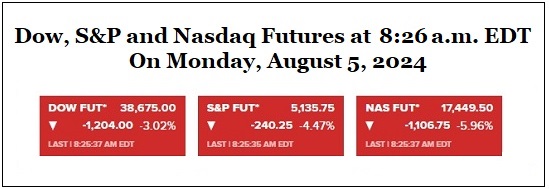by Pam Martens and Russ Martens, Wall St On Parade:

Japan’s Nikkei stock market index fell a stunning 4,451.28 points in overnight trading, marking the worst tumble in point terms in the entire history of the Nikkei. In percentage terms, that was a one-day trading loss of 12.4 percent.
Dow futures took their cue from the selloff in overnight foreign markets and tumbled a breathtaking 1200 points by 8:26 a.m. in New York. When the market actually opened at 9:30 a.m. the Dow had shaved off 1,167 points in the opening five minutes. As of 9:40 a.m., the Nasdaq had lost 819.8 points or 4.89 percent.
TRUTH LIVES on at https://sgtreport.tv/
Japanese traders were spooked by the sharp selloffs in U.S. markets on Thursday and Friday of last week, which were ushered in by bad economic data as well as the potential for a broader war in the Middle East.
On Thursday the Dow Jones Industrial Average fell 494.82 points or 1.2 percent while Nasdaq almost doubled that decline with a loss of 2.3 percent. The S&P 500 index closed with a loss of 1.4 percent.
Thursday’s selloff was fueled by the Institute for Supply Management (ISM) report that its measure of manufacturing activity had slumped to an eight-month low for the month of July, falling to 46.8 from a 48.5 level in June. A reading below 50 indicates a contracting manufacturing sector.
The reading cast more doubt on the Fed’s decision on Wednesday to hold steady on its high interest rates – pushing off the possibility of a Fed rate cut until September and raising the stakes for a full-blown recession in the U.S.
The markets were further unnerved on Friday morning at 8:30 a.m. when the monthly non-farm payroll report from the Labor Department’s Bureau of Labor Statistics (BLS) brought further hints of a recession. Non-farm payrolls had increased in July by a meager 114,000 – far below the average of 215,000 per month over the prior 12 months.
Friday’s economic data sent stock markets into another tailspin with the Dow losing 610.7 points or 1.51 percent; Nasdaq tumbling 417.9 points or 2.43 percent; and the S&P 500 (SPX) down 100.12 points or 1.84 percent by the closing bell.
The sharp two-day selloff in stocks sent traders into the safe-havens of gold and the 10-year U.S. Treasury note. As money moved into the 10-year U.S. Treasury note, its price moved higher with a concurrent drop in yield. From a 4 percent handle on Tuesday, the Treasury’s benchmark note is trading this morning to yield 3.70 percent. Gold’s December contract traded intraday on Comex on Friday at $2,522.50 an ounce – a new historic intraday high, before closing lower at $2,469.80.
Bitcoin, on the other hand, showed itself to be anything but a safe-haven trade or the much-touted substitute for gold. Bitcoin has fallen from a price level of more than $60,000 at the beginning of last week to around $50,000 this morning. To put that another way, Bitcoin is viewed just as risky – if not more risky – than stocks.
The CBOE’s Volatility Index known as the Vix is reflecting the wild gyrations in the stock market, moving from a range of 30 to 25 on Friday to spike as high as 65.73 this morning – the highest since the COVID-19 panic in 2020. As of 9:42 a.m. EDT, the Vix was trading at 54.16.
Read More @ WallStOnParade.com



